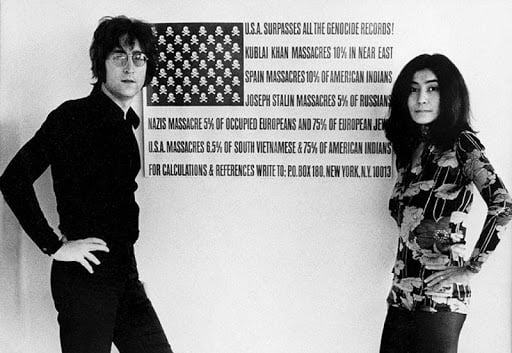Events and Parties
Fluxus Alive and Kicking in SoHo at “Dematerialized Auction”
Emily Harvey Foundation hosted a fundraiser for a film about George Maciunas.

Emily Harvey Foundation hosted a fundraiser for a film about George Maciunas.

Cait Munro


George Maciunas, The Dream of Fluxus.
Even in the middle of a now-gentrified SoHo, and despite profound and prolific signals that the experimental, avant-garde New York art scene of yore is gone for good (see Why I Believe New York’s Art Scene is Doomed), the spirit of Fluxus was alive and well on Saturday night.
At the Emily Harvey Foundation, nestled on Broadway between a Guess store and a Lucky Brand Jeans outpost (the space once housed Harvey’s eponymous gallery, showing exclusively Fluxus works—see Legendary Women Art Dealers You Need to Know, Part Two) an auction took place to support George, a forthcoming documentary about the movement’s fearless leader George Maciunas.
But it wasn’t your average charity auction. How could it have been? Fluxus is a movement rooted in blending visual art traditions with those of other disciplines, including literature, performance, and architecture to create something chaotic, enigmatic, and completely untraditional. Thus, the event was billed as a “Dematerialized Auction,” with the Xeroxed instructions for over 20 Fluxus performances available for “non-exclusive ownership.”
In the spirit of fairness and the subversion of the ‘art star’ paradigm, all the works had a starting bid of $50. Featured artists ranged from mainstays like Yoko Ono (whose signed Portrait of Mary score went for $360, the record price for the evening) and Alison Knowles (Make a Salad hammered for $230) to contemporary Fluxus artists, some of whom made pieces specifically for the auction. A highlight from the new works was Julia Pelta-Feldman’s contradictory Don’t Make a Salad.
The crowd was a reflection of the auction itself—attendees were either aging art enthusiasts, many of whom knew Maciunas and his compatriots personally, or hip twenty-somethings hungry for a taste of what made that period of modern art history (and New York history, for that matter) so special.
“[The Emily Harvey Foundation] is an important historical place…many Fluxus artists have lived in this building, and many Fluxus events have happened in this space. It’s much less frequently used for these kind of happenings now,” said Anitra Lourie, who organized the event alongside Fluxus scholar and Emily Harvey Foundation curator Jordan Carter. “But George talks a lot about SoHo at the time and the role of SoHo in the movement, which is something that I think the general public should know about and experience.”
If the auction itself somehow didn’t provide a real enough glimpse into the scene for the curious hipsters, the George clip screened beforehand certainly did the job. Directed by Jeffrey Perkins, the film relies on interviews with luminaries like Ono and Nam June Paik (who at one point breaks into a spontaneous fit of laughter so contagious you can’t help but join in) to support video footage of various happenings. The preview begins with a booming voice declaring that there must be “art for the people, art out on the streets, no more museums,” and includes a performance that took place in the very same spot as the auction, in which Maciunas, dressed in women’s clothes, disrobes alongside his new wife Billie Hutching.
“The word George just came into my mind, and I thought, this is going to be my next film. And because of my past history in Fluxus, I knew that it would be an interesting portrait of an artist,” said Perkins. “So I started building the film in 2010… Making a documentary film is a very adventurous project, and its had its ups and downs and ins and outs. I’ve been gifted great interviews…I feel that the film right now is ready to edit and basically this event is an effort to find money to fund the editing.”
But in addition to fundraising, the event also served as a reminder that Fluxus isn’t a movement of the past. Its spirit is still very much present in work being created today, especially in new media disciplines, and some contemporary artists even identify their work as Fluxus, despite being born years after the movement reached its pinnacle. “We hope that this event will open up a dialogue that will extend the walls of the Emily Harvey Foundation regarding the ‘meaning’ of Fluxus in our post-digital age,” a press release stated.
Similarly, pieces that were created as part of the movement in the ’60s are now entering museum collections and a level of gaining monetary value that was never present before. “[Fluxus] objects had very little value at the time,” explained Carter. “But now that they are being entered into these museum collections alongside other artists of the same time, it’s kind of changed and a lot of it has become more accessible.”